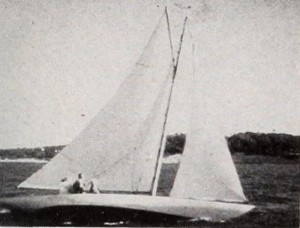
"In Reflections, Henry E. Hird has followed the intelligent practice of revising footage shot when film was more plentiful, with the result that he has created a new and interesting synthesis by editing. On a winter evening, a man reflects on the joys and adventures of a past summer. Of an athletic disposition, he has swum, sailed and hunted. Interested in wild life, he has observed and filmed birds. From time to time, he adjusts a radio, to find music that expresses the moods of his reverie. Finally, he turns off the radio, the musical accompaniment ceases and the film ends in silence. With excellent cinematography and with a nice editorial sense, Mr. Hird has gathered interesting events into an entertaining whole." Movie Makers, Dec. 1944, 496.
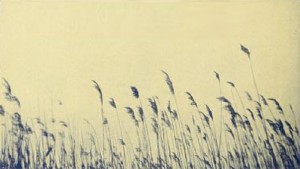
"The first on the list, Rushes, 300 ft., 16mm., filmed by J. V. D. Bucher, is an unusual effort, for it presents a continuity theme woven about a single subject, the wild rice plants in a marsh. It well illustrates what distinctive subjects for amateur movie making are offered by scenes close at hand that are often ignored. It is a satisfyingly beautiful study of the rushes, telling the story of their resistance to the assaults of nature, climaxed with their defeat by fire. The plan offered a large number of exposure problems which were successfully handled. Of particular beauty are the scenes of the burning rushes, taken with a fast lens, and fog effects and closeups of the plants' plume like heads, taken with filters against cloudy skies. The continuity motif used is simple and yet unites the subject into a complete entity rather than a series of disjointed sequences which happened to be taken of the same subject." Movie Makers, Dec. 1930, 758.
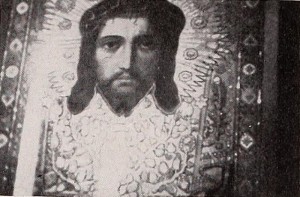
"Russian Easter is a reverent and impressive film of the celebration of Easter in the Russian Orthodox Church and in the homes of Russians living in this country, all presented against the background of the birth of spring. Easter in the Russian Church is more closely associated with the coming of spring than it is in some other faiths, and the antiphonal cry, "Truly Christ is risen!" finds its response in leafing trees, budding flowers and virescent hillsides. Accordingly, this is a joyful film, filled with the gladness of Easter and of spring. The rich liturgy of the Easter season in the Russian Church is presented with intelligently planned sequences that span the time from the beginning of Lent to three days after Easter. Interwoven are sequences of home life, as the household prepares for the celebration and the feast at Easter. So, the picture actually consists of three themes — Easter in the church, Easter in a private home and the coming of spring, all interrelated by a masterly handling of film planning and editing. Outstanding scenes in this picture are the shots of Church of Alexander Nevsky in the winter snow, looking like a color print of old Russia, and the shots of the dinner, after Easter services, when family and guests eat the traditional Easter dishes. This latter sequence has particular grace and charm. Mr. Serebrykoff has made a sincere and delightful film that bolsters one's faith in the future of amateur movie making, for he has produced a brilliant picture that could be made only by an amateur in the full and accurate sense of the word — a film that would have been profaned by professionalism." Movie Makers, Dec. 1942, 489.
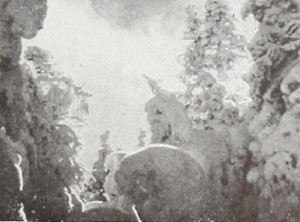
"Robert P. Kehoe accepted a strong challenge and secured a fine result in filming Snow on the Mountains. Filming so static a subject as snow forms, iced trees and wind storms on a mountain presents a real task of vitalizing the material. Mr. Kehoe has brought weird and beautiful life to the screen. This film, excellently scored to present the musical message suggested by the snow scenes, builds from the pleasantness of subdued ice and snow forms, through the almost animate figures created by winter on trees and bushes, to a breath taking climax of a snow storm on the mountain. Culminating the beautifully edited and intelligently filmed footage is an inspiring sequence of flaming powdered snow, reflecting the full crimson of the sunset. So remarkable is this action that the impression imparted is almost one of a cascade of liquid fire flowing across the screen. In order to secure many of the scenes, Mr. Kehoe stood so long in the snow that it was necessary actually to lift him into a motor car and to remove the cine equipment from his chilled hands at the end of his task." Movie Makers, Dec. 1944, 494.
"Springtime in California, by F. B. Judson, ACL, is an example of what every Kodachrome filmer would be proud to have made, because it studies Nature in her most extensively colorful manifestations, with complete freedom of camera viewpoint, offering closeups, medium shots and long views, all of them richly hued. This film indicates a delicate appreciation of color on the part of its maker, who. having a highly chromatic subject to his hand, did not let it run away with him. but kept it well under control, with the result that he delights with his management of pastel shades, where another might have omitted these and substituted garish footage so easily available in the highly colored California landscape. Mr. Judson is awarded Honorable Mention because he has done a typical thing — a Kodachrome landscape study — with restraint and liveliness, combining two qualities not always found together." Movie Makers, Dec. 1935, 553.
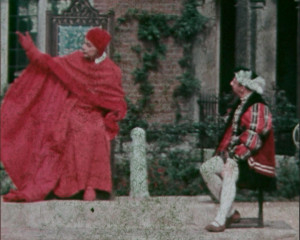
A film that features various scenes and activities during the summer in Norfolk.
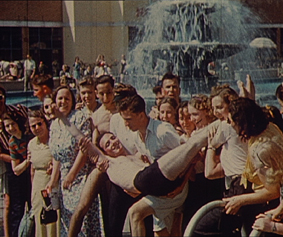
Amateur colour film of a fundraising carnival and summer activities at Clacton-on-Sea in the month before World War II was declared. (EAFA)
"In the fall of the year, the late flowers are blooming, the evergreens have about completed their year's growth in preparation for the heavy winter, the deciduous have donned their golden mantles soon to become their winter blanket. All part of the thanksgiving for a bountiful season. The tall golden hillside trees set in a great panorama, interspersed with the dark grenes, the paths carpeted with golden leaves of varying hues of yellow, orange and red. It is here we visit the Mortons with their trailer in the pines" PSA Journal, Nov. 1959, 49.
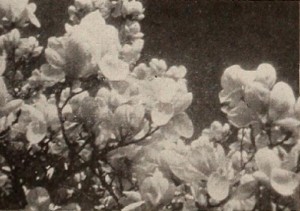
"It is spring in Brooklyn, and Leo J. Heffernan has found a multitude of trees there. He opens the film with a sombre shot of New York's waterfront and skyline, to indicate the tense activity of a large city. A title suggests that those who live in the midst of this turmoil can find solace not far away. The film proceeds to the bounteous display of flowering trees in a large public park. Glowing shots of heavily laden branches against blue sky are interspersed with scenes of Sunday strollers wandering through shaded walks and falling petals. Mr. Heffernan has used to good effect his fine technical skill, and his color transitions between scenes are smoothly accomplished. Trees That Grow in Brooklyn is accompanied by a rhymed narrative written especially for the film by Mr. Heffernan." Movie Makers, Dec. 1946, 489.
Total Pages: 6